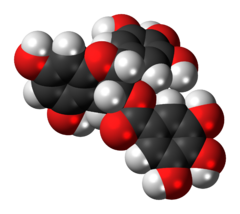
| |

| |
| Names | |
|---|---|
| IUPAC name
(2R,3R)-3′,4′,5,5′,7-Pentahydroxyflavan-3-yl 3,4,5-trihydroxybenzoate
| |
| Systematic IUPAC name
(2R,3R)-5,7-Dihydroxy-2-(3,4,5-trihydroxyphenyl)-3,4-dihydro-2H-1-benzopyran-3-yl 3,4,5-trihydroxybenzoate | |
| Other names
(-)-Epigallocatechin gallate
(2R,3R)-3′,4′,5,5′,7-pentahydroxyflavan-3-yl gallate | |
| Identifiers | |
3D model (JSmol)
|
|
| ChEBI | |
| ChEMBL | |
| ChemSpider | |
| ECHA InfoCard | 100.111.017 |
| KEGG | |
| MeSH | Epigallocatechin+gallate |
PubChem CID
|
|
| UNII | |
CompTox Dashboard (EPA)
|
|
| |
| |
| Properties | |
| C22H18O11 | |
| Molar mass | 458.372 g/mol |
| soluble (5 g/L)[vague][1] | |
| Solubility | soluble in ethanol, DMSO, dimethyl formamide[1] at about 20 g/L |
Except where otherwise noted, data are given for materials in their standard state (at 25 °C [77 °F], 100 kPa).
| |
Epigallocatechin gallate (EGCG), also known as epigallocatechin-3-gallate, is the ester of epigallocatechin and gallic acid, and is a type of catechin.
EGCG – the most abundant catechin in tea – is a polyphenol under basic research for its potential to affect human health and disease. EGCG is used in many dietary supplements.
- ^ a b "(-)-Epigallocatechin gallate". Chemicalland21.com.